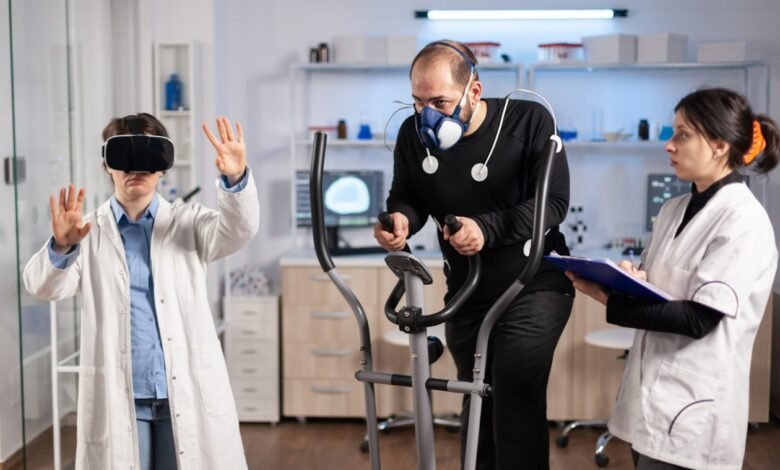The Future of Augmented Reality in Healthcare: What to Expect in the Coming Years

In recent years, augmented reality (AR) has made significant strides in various industries, from gaming and entertainment to education and manufacturing. However, one of the most promising and impactful applications of AR is in healthcare. This article will explore the future of augmented reality in healthcare and what we can expect in the coming years.
Augmented reality, a technology that overlays digital information and virtual objects onto the real world, has gained prominence in healthcare for its potential to revolutionize patient care, medical training, and more. As technology advances, the future of augmented reality in healthcare looks incredibly promising.
Understanding Augmented Reality in Healthcare
Before diving into the potential applications and benefits, it’s crucial to understand what augmented reality is in healthcare. Augmented reality uses devices like headsets or smartphones to superimpose digital content onto the user’s view of the physical world. In healthcare, this can involve medical data, 3D models of organs, or even real-time information during surgery.
Benefits of Augmented Reality in Healthcare
Improved Visualization
Augmented Reality in Healthcare: One of the primary advantages of AR in healthcare is improved visualization. Surgeons can use AR to access 3D models of a patient’s anatomy, enhancing precision and reducing the risk of complications during surgery.
Enhanced Medical Training
Medical students and professionals can benefit from AR-based simulations and training programs. These immersive experiences can provide hands-on learning without the need for cadavers or real patients.
Remote Consultations and Diagnostics
AR enables remote consultations between patients and healthcare providers. Physicians can diagnose and treat patients from a distance, which is especially valuable in rural or underserved areas.
Applications of AR in Medical Training
Augmented reality is transforming medical education. Students can use AR headsets to interact with virtual patients and practice complex procedures in a risk-free environment. This innovative approach to training enhances skills and confidence among future healthcare professionals.
Enhancing Patient Care with AR
In the future, patients may benefit from AR during their hospital stays. AR can offer real-time information about medications treatment plans, and even provide entertainment to alleviate stress and anxiety.
Read More: The Top 10 Health Tech Trends for 2023
Augmented Reality in Surgery
One of the most exciting developments is the use of AR in surgery. Surgeons can access critical information directly in their field of vision, improving precision and minimizing errors. This technology has the potential to revolutionize complex surgeries.
Remote Consultations and Diagnostics
Augmented Reality in Healthcare: Telemedicine is rising, and AR is pivotal in making remote consultations more effective. Doctors can use AR to examine patients and diagnose from a distance, ensuring timely medical care for those in need.
AR in Rehabilitation and Physical Therapy
Augmented Reality in Healthcare: Augmented reality (AR) in rehabilitation and physical therapy is a promising avenue that can revolutionize how patients recover from injuries and regain mobility. This innovative application of AR technology offers several advantages, making it an exciting healthcare development area.
Enhancing Engagement and Motivation
One of the key benefits of AR in rehabilitation is its ability to engage and motivate patients. Traditional physical therapy exercises can often become monotonous and tedious, leading to reduced compliance. AR changes this by introducing gamification elements into therapy sessions. Patients can interact with virtual objects or complete exercises in an immersive, enjoyable environment. This makes the process more engaging and encourages patients to adhere to their treatment plans consistently.
Personalized Treatment Programs
AR enables the creation of personalized treatment programs. By tracking a patient’s progress and adjusting exercises accordingly, therapists can tailor rehabilitation plans to meet each individual’s unique needs. This level of personalization ensures that patients receive the most effective therapy, leading to faster and more successful recoveries.
Real-time Feedback and Monitoring
AR systems can provide real-time feedback to both patients and therapists. During exercises, patients can receive visual cues and guidance to ensure they perform movements correctly. On the other hand, therapists can monitor progress remotely and make immediate adjustments to the treatment plan as needed. This real-time feedback loop enhances the quality of care and contributes to better outcomes.
Pain Management and Distraction
AR can serve as an effective pain management tool for patients dealing with pain during their rehabilitation process. Immersive AR experiences can divert patients’ attention from discomfort or pain, allowing them to focus on their exercises. This distraction can be especially valuable in chronic pain or post-surgery recovery cases.
Remote Rehabilitation
AR can facilitate remote rehabilitation in scenarios where patients cannot attend in-person therapy sessions, such as during a pandemic or due to geographical constraints. Patients can receive guided therapy sessions at home through AR applications, ensuring continuity of care.
Data-driven Decision Making
AR systems collect valuable data about a patient’s progress and performance. Therapists can use this data to make informed decisions about treatment adjustments and track the effectiveness of specific interventions. This data-driven approach to rehabilitation enhances the quality of care and contributes to evidence-based practices.
In the coming years, we can expect continued advancements in AR technology for rehabilitation and physical therapy. As the field evolves, it is crucial to address challenges such as data privacy and security, accessibility of AR devices, and integrating of AR into existing healthcare systems. Nevertheless, the potential benefits for patients and therapists make AR in rehabilitation a promising avenue that promises to improve recovery outcomes and enhance the overall patient experience.
Challenges and Concerns
While the future of augmented reality in healthcare is promising, it’s not without challenges. Concerns about data privacy, the need for robust regulations, and the cost of AR devices must be addressed to ensure safe and equitable implementation.
The Role of Wearable AR Devices
Wearable AR devices, such as smart glasses, are becoming more accessible. These devices can potentially empower healthcare professionals with real-time information at their fingertips, enhancing their decision-making capabilities.
Regulatory Considerations
Regulatory bodies must adapt to the rapidly evolving field of AR in healthcare. Clear guidelines are needed to ensure patient safety and the ethical use of this technology.
Investment and Research Trends
Investment in AR research and development is rising, with public and private sectors recognizing its potential. As more resources are dedicated to AR innovation, we can expect groundbreaking developments in healthcare.
Ethical and Privacy Implications
AR in healthcare raises ethical questions regarding patient consent and data security. Striking a balance between technological advancement and ethical considerations is crucial.
Patient Education and Empowerment
AR can empower patients by giving them a deeper understanding of their conditions and treatment plans. Informed patients are more likely to actively participate in their healthcare journey.
Read More: Things to Pay Attention Before Choosing a Healthcare App Development Company in 2023
Conclusion
The future of augmented reality in healthcare holds immense promise. From improving surgical precision to enhancing medical training and patient care, AR is poised to transform the healthcare landscape. However, it is essential to address privacy, regulation, and ethics challenges to ensure that AR benefits all stakeholders.
However, as we embark on this exciting technological journey, it is essential to address several critical factors. These include ensuring data privacy and security in collecting and handling sensitive patient information, developing clear regulatory guidelines to govern the ethical use of AR in healthcare, and mitigating the costs associated with AR technology and devices.
As investment and research trends continue to surge in the field of augmented reality, we can anticipate groundbreaking developments that will shape the future of healthcare. By striking a balance between technological advancement and ethical considerations, we can harness the full potential of augmented reality to benefit all stakeholders in the healthcare ecosystem—patients, healthcare providers, and medical professionals alike.
FAQS
How does augmented reality improve surgical procedures?
Augmented reality enhances surgical procedures by providing real-time, 3D visualizations of a patient’s anatomy during surgery. Surgeons can overlay crucial information, such as imaging scans or vital signs, directly onto the patient, improving precision and reducing the risk of complications.
Are there any privacy concerns associated with using AR in healthcare?
Yes, privacy is a significant concern with AR in healthcare. The collection and storage of patient data, especially in augmented reality applications, must adhere to strict privacy regulations to ensure the confidentiality and security of sensitive medical information.
What role can wearable AR devices play in patient care?
Wearable AR devices, like smart glasses, can provide healthcare professionals instant access to patient data, treatment plans, and medical records, improving efficiency and enabling better decision-making at the point of care. Patients can also benefit from AR by receiving real-time information and guidance during their medical journey.
How is medical education benefiting from augmented reality?
Augmented reality revolutionizes medical education by offering immersive and interactive experiences. Medical students can visualize complex anatomical structures, simulate surgical procedures, and participate in virtual patient interactions, enhancing their learning and understanding of medical concepts.
What are the key challenges in implementing AR in healthcare?
Implementing AR in healthcare faces challenges such as data security and privacy concerns, high costs of AR devices and technology, regulatory compliance, and the need for comprehensive training for healthcare professionals. Overcoming these challenges is essential for the successful integration and widespread adoption of AR in the healthcare industry.










